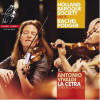Texte paru dans: / Appeared in:
*

International Record Review - (09/2012)
Pour
s'abonner / Subscription information
Channel Classics
CCSSA33412

0723385334125 (ID234)
Consultez toutes les évaluations recensées pour ce cd
~~~~ Reach all the evaluations located for this CD
‘La cetra’ (‘The Lyre’) is representative of Vivaldi’s mature style. Its 12 concertos, 11 for solo violin and one for two solo violins, are impressive if not, perhaps , uniformly so ; but the collection as an entity is an affirmation of Vivaldi ‘s fluent artistry and fertile imagination both as composer and, by extension, virtuoso violinist. The printed set, issued in 1727 as his Op. 9, was dedicated to the Austrian emperor Charles VI. He was a generous patron of the arts with whom the composer was personally acquainted. In the following year Vivaldi dedicated a second set of concertos to the emperor, which confusingly he also titled ‘La cetra’ but which remained in manuscript and has survived incomplete.
Rachel Podger and the Holland Baroque Society have recorded the concertos in the printed version of 1727. Many readers may be more familiar with some of Vivaldi’s earlier concerto sets, notably ‘L’estro armonico’ , ‘ La stravaganza’ and the set which contains the ‘ Four Seasons’ , ‘Il cimento dell’armonia e dell’inventione ‘ . While these are absolutely indispensable to lovers of Vivaldi’s art there is music in ‘La cetra’ from which I derive even deeper satisfaction. Unlike ‘L’estro armonico’ it blazes no trail, nor does it contain works with programmatic content. Instead it offers music that is full of fantasy, lyrically poetic and redolent with subtle contrasts in mood and in colour. Indeed, the sixth and twelfth concertos of the set call for scordatura tuning of the solo violin, allowing Vivaldi to realize distinctive sonorities within an adjusted compass.
Podger is just the kind of Vivaldian to unlock the treasure chest of ‘La cetra’. Her playing possesses tonal and expressive warmth, her treatment of slow movements is tender and her easy virtuosity together with a fluently informed sense of apposite style holds our attention throughout. Most of all her lightly bowed articulation makes a welcome change from a mainly continental ‘nouvelle vague ‘of exaggerated theatricality and aggressive pyrotechnics, too often at the expense of the music’s inherent poetry. Her playing of the First Concerto of the set provides an instance of what I mean. The Largo is lovingly sustained, its contours warmly caressed and its ornaments a model of discretion. Sometimes I found myself more prominent and the substantial continuo cadre a little less assertive. The continuo, though, often makes a distinctive and affective contribution, as in the Largo of the Concerto No. 2 in A major, where lute, cello and organ underpin with fairy-tale magic Podger’s irresistible bowing of its tender melody. Occasionally, though, it strikes my ears as a little over-zealous as, for instance, in the third movement of the D minor Concerto (No. 8).
For the most part, the solo playing here has opened my ears to subtleties overlooked, forgotten or hitherto undiscovered. We might consider the two scordatura Concertos, No. 6 in A major and No. 12 in B minor, as the crowning glories of the set. Both contain solo passages with extended bariolage which hold our emotions in suspense. This is especially so in the B minor work, one of Vivaldi’s greatest achievements in the concerto sphere . In the third solo section of its first movement, a moment of real magic, the soloist accompanies the first violin of the tutti, which sustains a cantilena of lyrical beauty. Here and in the restless triadic arpeggio patterns in the opening movement of the Tenth Concerto in G major Podger avoids exaggerated virtuosity, instead bringing to the music more softly spoken inflections, which, by the way, inform each and every one of the sets slow movements. Her partnership with Judith Steenbrink in Concerto No. 9 in B flat for two violins is another pleasing dimension in a recording which I shall treasure.
Only one feature of the project calls forth mild protest. The First Concerto is introduced by an improvised prelude deriving from the initial seven bars of its opening movement. Is it to get us into Vivaldi’s rhythmic world? It probably goes down a storm at a concert but in the context of a CD it becomes irritating and redundant upon unavoidable repetition.
‘La cetra’ has been my constant companion
through thick and thin, ever since I first heard it in 1957 in a version on
Vox with Reinhold Barchet. This newcomer has once more laid bare my
susceptibilities and raised my excitement to fever pitch.
Help, I shall soon be on tranquillizers .
Fermer la fenêtre/Close window
Cliquez l'un ou l'autre
bouton pour découvrir bien d'autres critiques de CD
Click either button for many other reviews


